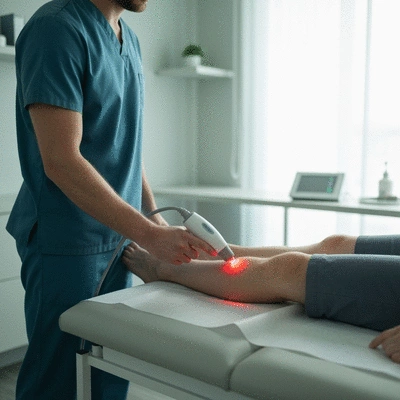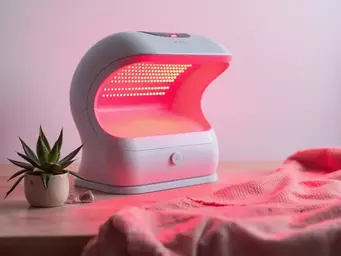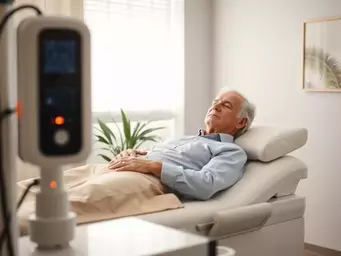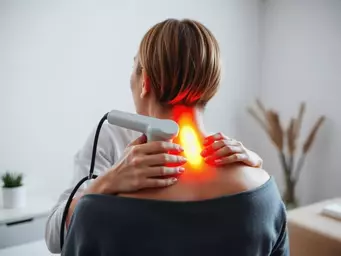LLLT Advantage
Non-Invasive Nature
LLLT delivers energy without breaking the skin, providing a safe and comfortable treatment experience with no surgical risks or injections.

Curious about how a simple beam of light can transform healing? Low-level laser therapy (LLLT) is redefining pain management and recovery, offering a non-invasive alternative that harnesses the power of light to stimulate healing processes in our own bodies. Let’s delve into the essential insights surrounding this innovative therapy.
Low-Level Laser Therapy stands out against traditional methods in several key areas, offering a non-invasive and often more comfortable treatment experience.
LLLT delivers energy without breaking the skin, providing a safe and comfortable treatment experience with no surgical risks or injections.
Often involves surgery, injections, or medications with potential side effects and longer recovery periods.
Patients typically experience no downtime, allowing for immediate return to daily activities after treatment.
Recovery can range from days to weeks, depending on the invasiveness of the procedure.
LLLT is generally well-tolerated with minimal to no reported side effects, making it a safer choice for many.
Medications can cause systemic side effects, while surgical procedures carry risks of infection, scarring, and complications.
Low-level laser therapy, commonly referred to as LLLT, represents a cutting-edge approach in the realm of non-invasive healing solutions. By utilizing specific wavelengths of light, LLLT stimulates cellular processes that can lead to significant improvements in pain management and recovery. At Erchonia Laser, we are committed to sharing insights and evidence on the transformative benefits of this innovative therapy, empowering both healthcare professionals and patients.

As we explore LLLT, it’s essential to understand its underpinnings. This therapy operates on the principle of photobiomodulation, where light energy is absorbed by cells, initiating various biological responses. This is not just about shining a light; it’s about activating the body’s innate healing capabilities!
At its core, LLLT is a form of light therapy that uses low levels of laser light to promote healing. Unlike traditional lasers that can cut or destroy tissue, LLLT delivers energy without generating heat, making it a safe option for pain relief and recovery. The therapy is often utilized in treating various conditions, ranging from chronic pain to sports injuries.
These features make LLLT an attractive alternative for those seeking effective, non-invasive modalities in their healing journey.
Understanding the mechanisms of LLLT can be complex, but it begins with its ability to enhance cellular function. The therapy effectively stimulates cellular metabolism, which accelerates recovery processes in the body. By focusing on how light interacts with cells, we can appreciate its profound effects on healing.
One of the key players in this process is cytochrome c oxidase, an enzyme vital for ATP (adenosine triphosphate) production. When laser light penetrates the skin, it targets cytochrome c oxidase, which in turn boosts ATP synthesis. This increase in energy is crucial for cellular repair and function, allowing for enhanced healing.
At a cellular level, photochemical reactions occur when the laser light is absorbed by the mitochondria, the powerhouse of the cell. Activated mitochondria enhance metabolic activity, which leads to reduced inflammation and improved tissue regeneration. Isn’t it fascinating how light can influence our cells?
LLLT doesn’t just stimulate cells; it orchestrates a variety of biochemical processes that contribute to healing. Understanding these processes is crucial for recognizing the full potential of this therapy.
Through photobiomodulation, cells experience enhanced functions such as proliferation, migration, and differentiation. This means that LLLT not only aids in healing existing injuries but also encourages the growth of healthier cells, fostering long-term wellness.
Nitric oxide is another critical component in the LLLT landscape. This molecule plays a significant role in vasodilation, which helps improve blood flow to injured areas, further supporting recovery. By increasing nitric oxide levels, LLLT can alleviate pain and enhance the healing process.
The effectiveness of LLLT also heavily relies on the wavelength of light used. Different wavelengths penetrate the skin to varying depths, which can impact treatment results. For instance, shorter wavelengths may be more effective for superficial conditions, while deeper tissues might require longer wavelengths. This tailored approach is crucial for achieving optimal outcomes!
Lastly, energy density—the amount of energy delivered per unit area—is vital in determining the success of LLLT. An appropriate energy density ensures that enough energy reaches the targeted area to promote healing without causing harm. This balance is crucial for practitioners when designing treatment protocols.
By understanding these mechanisms, we can appreciate how LLLT serves as a powerful tool for healing and wellness. At Erchonia Laser, we strive to provide resources that help both healthcare professionals and patients grasp the science behind this innovative therapy. Stay tuned as we explore the therapeutic benefits of LLLT in the following sections!
We'd love to hear your thoughts! How do you perceive the effectiveness of low-level laser therapy (LLLT) compared to traditional pain management methods? Share your experiences or opinions below:
As we explore low-level laser therapy (LLLT), it’s essential to compare it against more traditional therapies. This evaluation helps us understand where LLLT fits in the larger landscape of pain management and healing solutions. At Erchonia Laser, we believe that informed choices lead to better outcomes, so let's dive into what makes LLLT unique!
When considering treatment options, the distinctions between LLLT and traditional therapies can be significant. Here’s a quick comparison to help clarify:
By weighing these factors, it becomes clear how LLLT offers a compelling alternative for patients seeking effective pain management without the risks often associated with traditional therapies.
In my experience, LLLT stands out among other pain management techniques such as medications, acupuncture, and physiotherapy. While medications may provide quick relief, they often come with unwanted side effects. On the other hand, LLLT promotes healing at the cellular level through photobiomodulation. This unique approach not only alleviates pain but also supports the body’s natural healing processes. Isn't it exciting to know that you can enhance recovery without the drawbacks of conventional treatments? Studies have shown LLLT to be effective in various conditions, underscoring its potential.

While LLLT is generally safe, there are some contraindications to keep in mind. Patients should always consult with a healthcare professional to determine if LLLT is the best option for their specific condition. Key considerations include:
Being aware of these factors ensures that patients make informed decisions about their treatment options.
Integrating LLLT with traditional therapies like acupuncture and physiotherapy can yield remarkable results. Many practitioners find that combining these modalities enhances overall effectiveness. For instance, acupuncture can stimulate points that may help enhance the effects of LLLT. Similarly, physiotherapy can prepare the tissues for laser treatment, maximizing recovery. This collaborative approach truly embodies our mission at Erchonia Laser to provide comprehensive, patient-centered care.
As we look to the future, it’s important to stay updated on the latest developments in LLLT. With continual advancements in technology and research, this field is rapidly evolving, and I’m excited to share these insights with you!
Research continues to support the efficacy of LLLT, revealing new insights and applications. Some of the most promising trends include:
These trends not only inspire further exploration of LLLT but also highlight its potential to transform pain management practices.
Numerous studies are emerging that validate the benefits of low-level laser therapy. These studies often focus on its ability to reduce inflammation, accelerate healing, and improve overall patient outcomes. With robust evidence backing LLLT, we’re excited to see how it will reshape the future of pain management.
Staying informed is key to making the best health decisions. Here are some resources I recommend for both patients and professionals:
By engaging with these resources, you’ll stay at the forefront of LLLT advancements that could benefit your health journey.
In summary, low-level laser therapy offers a unique and effective approach to pain management and healing. Its versatility and non-invasive nature make it an appealing option for many patients. I encourage you to explore how LLLT can fit into your health needs!
As we reflect on the benefits of LLLT, it's clear that this therapy not only alleviates pain but also promotes healing at the cellular level. The continuous research and success stories associated with LLLT reinforce its potential as a leading solution in the realm of non-invasive therapies.
If you’re considering low-level laser therapy, don’t hesitate to reach out! At Erchonia Laser, we’re passionate about guiding you on your journey to wellness. Let’s illuminate your path to pain relief together!
Here is a quick recap of the important points discussed in the article:
Understanding Red Light Therapy

Curious about how light can play a pivotal role in healing? The world of light therapy is rich with
Erchonia Laser Therapy for Pain Management

Curious about a non-invasive solution to chronic pain? Erchonia Laser Therapy is emerging as a revol
Relieving Neck and Shoulder Pain

Consider this: neck and shoulder pain affects millions, yet many are unaware of the root causes. Und
Understanding Red Light Therapy
Erchonia Laser Therapy for Pain Management
Relieving Neck and Shoulder Pain
Erchonia Laser and Back Pain Outcomes
Exploring Erchonia's Laser Technology Science